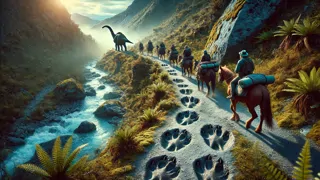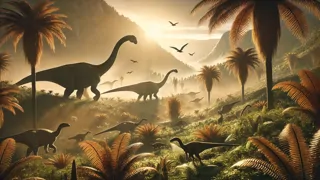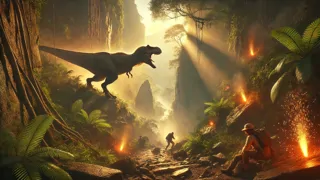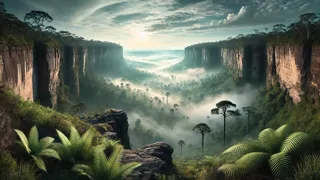Introduction
In the summer of 1924, under a shifting sky of leaden clouds, an unusual expedition set forth from the remote moors of northern England. The air carried a briny chill that spoke of sealing cliffs and distant seas, even as the rolling heathland seemed endless ahead. At its heart stood paleontologist Dr. Evelyn Hart, resolute and driven by the promise of discovery beyond any fossil bed she had ever studied. Alongside her marched three companions—cartographer Samuel Ortega, whose meticulous maps had ever failed to mark the plateau they now sought; Captain Margaret Sinclair, a no-nonsense veteran of Arctic voyages; and the enigmatic financier Lord Theodore Arbington, who funded the journey with hushful intensity. Local villagers spoke in hushed tones of a “Forbidden Plateau” nestled above the cairns and crags, veiled in swirling mists and rumored to shelter creatures that time had forgotten. Skeptics dismissed these tales as superstition, but tantalizing clues lay scattered at the mountain’s base: gigantic footprints gouged in mud beside fern fronds, fossilized skin impressions embedded in rocks, and roars that echoed like rolling thunder at daybreak. United by a shared hunger for the unknown, the team loaded crates of surveying gear, botanical presses, preserved meats, and specialized lenses into sturdy packhorses. Each step up the winding path sent spirits soaring with anticipation, as chart and compass seemed to betray them with every switchback. Yet nothing could have prepared them for the first glimpse at dawn of a vast, rocky plateau carpeted in lush, primeval greenery—an island suspended high above the familiar world, promising wonders both sublime and terrifying. Here at the edge of human understanding, the expedition would soon face living legends that leapt from the pages of prehistory and challenge beliefs about life’s improbable persistence.
Journey to the Forgotten Plateau
At first light, the expedition caravans wound their way along a narrow highland trail carved into sheer granite faces. Packhorses labored under wooden crates brimming with rock hammers, steam-powered cameras, preserved specimens, and rationed supplies of salted meat and hard tack. Dr. Evelyn Hart rode at the front, her eyes scanning every jutting crag and swath of bracken that could conceal a fossil bed or secret passage. Behind her, Samuel Ortega consulted worn charts, tracing inked lines that abruptly stopped at the mountains’ base as if the plateau above defied mapping. Captain Margaret Sinclair brought up the rear, her steady presence a bulwark against trembling nerves as the wind howled down from fog-shrouded summits. With every foothold gained, rich scents of damp earth and crushed wildflowers rose from the undergrowth. At the turn of a hairpin bend, the group paused when Samuel raised his hand in silent alert: oversized three-toed footprints pressed into a shallow creek bed, each one deeper than the tallest man was high. Moss and ferns clung to these curious impressions, suggesting a colossal creature had only recently passed. A hush fell over the party as Dr. Hart knelt to examine the prints, her pulse quickening at the evidence that on this plateau, the past had come alive.

Intrigued and apprehensive, the team pressed upward, each step carried out with scientific precision and an undercurrent of wonder. Shadows of ragged cliffs stretched across the trail as they approached a narrow ravine filled with prehistoric ferns and towering horsetail plants reminiscent of the Carboniferous age. Samuel knelt to photograph a cluster of giant leaf imprints embedded in slick rock faces, while Dr. Hart’s gloved fingers traced the delicate veins preserved in limestone. The air grew warmer here, humid and perfumed with damp vegetation, reminding them of equatorial jungles—and hinting at climatic anomalies on the plateau that defied expectations. Suddenly, the distant thunder of wings reverberated overhead, and Captain Sinclair nudged the group against a boulder just as a pack of small, dagger-toothed raptors skidded across the ridge crest. Their elongated snouts and glinting eyes betrayed a keen intelligence. For a heart-stopping moment, muscles tensed and breaths caught, before the predators veered away down the slope in pursuit of prey unseen. The fleeting sight confirmed what the footprints had suggested: this lost world teemed with living dinosaurs, each step deeper unfolding new marvels and fresh dangers.
As noon heat filtered through thinning mist, the explorers emerged onto a broad terrace framed by sheer cliffs that fell into a deep chasm below. A gentle brook meandered through thick mat-covering the ground, its banks fringed with cycads and palms which seemed transported from the Mesozoic era. Dr. Hart, Samuel, and Captain Sinclair set up a temporary camp beside the water’s edge, erecting canvas shelters and deploying instruments to measure barometric pressure and temperature. Lord Arbington, whose presence had been quiet yet commanding, paced the lip of the cliff and studied the rocky horizon, guessing at where plateaus might rise beyond sight. Lunch was silenced by slow, deliberate roars that echoed like distant artillery, rattling even the stoutest tents. The team exchanged wary glances, realizing they were not alone—and not merely overshadowed by diminutive hunters but by titanic behemoths whose voices could reshape the air. Armed with compact rifles loaded with tranquilizer darts and cameras stocked with black-and-white film, they prepared to document the first living sauropods in over sixty-five million years.
Nightfall brought a surreal tranquility as the sky bloomed with stars unseen from the valley below. Campfires sputtered against the hush, casting warm glows on canvas and stone. Around the flickering light, the explorers shared whispered theories of how an isolated ecosystem had survived unnoticed for centuries. Dreams of Jurassic giants danced behind eyelids until faint earth tremors awakened them—soft at first, then growing until tents shuddered underfoot like the drums of an ancient tribe. Distant silhouettes passed atop a ridge, too massive for flesh and bone, too deliberate for wind, carrying the legacy of the prehistoric world. Hearts pounding, each member gripped a weapon or notebook, knowing sleep would escape them until they had braved the plateau’s deepest mysteries. As embers glowed, hope and terror entwined in equal measure, setting the stage for the discoveries—and perils—that lay beyond the next sunrise.
By the following morning, the plateau’s true scale revealed itself. Gouged embrace of volcanic rock gave way to lush hollows, and the distant thud of enormous footfalls resonated across wide meadows. The expedition advanced toward a colossal shadow that stretched across tufts of silver ferns: the neck of a great sauropod, elegantly arching toward the canopy as it fed among crimson blooms of cycads. The creature’s skin rippled with emerald and russet patterns, scales like overlapping shields forged by time itself. Cameras clicked and notebooks filled with meticulous sketches as the explorers observed in silent awe. Every fiber of their being tingled with the knowledge that this moment, suspended between science and legend, would redefine natural history. Unbeknownst to them, behind the viewer’s lens and careful measurements, forces within the lost world were stirring, preparing for a confrontation that would test their courage to its limits.
Encounters with the Behemoths
After a restless night beneath star-freighted skies, the team awoke to a soft glow of dawn filtering through their canopy of intertwining branches. A low mist drifted across the meadows ahead, transforming every boulder and fern into a ghostly vision. Samuel Ortega’s theodolite traced the plateau’s hidden contours, while Dr. Hart traced fossilized tracks leading toward a shallow depression. Captain Sinclair moved quietly among the tents, issuing orders to pack gear and ready the cameras. Lord Arbington stood atop a natural rock dais, binoculars sweeping the woodland fringe for signs of movement—signs soon heard rather than seen: a distant rumble, like tidal waves crashing in reverse, rolled in through the valley, sending a thrill of anticipation through even the most pragmatic souls.

Crossing the dewy carpet of grasses, the party descended into a glacial valley cradled by steep ridges streaked with mineral veins. There, they spied the silhouettes of long-necked sauropods, their colossal forms partially obscured by drifting vapor. Towering as living towers, these gentle giants bent their heads to pluck tender shoots and cycads, each mouthful releasing a plume of fine mist from nostrils the size of dinner plates. Dr. Hart scribbled enthusiastic notes on cranial structure, while Ortega adjusted lenses to capture every scale detail. The deep resonant pulses of each step seemed timed to ancient rhythms, and a hush fell as the explorers realized that conditions on the plateau—temperate temperature, abundant foliage, and natural watercourses—had fostered a self-sustaining ecosystem lost since the Cretaceous period.
But awe turned to alarm when a thunderous snap echoed from a crumbling boulder field. From the shadows emerged a lithe, sinewed predator—its eyes gleaming, jaws lined with dagger-like teeth that glinted wickedly in morning light. A Tyrannosaurus rex, majestic and merciless, had descended to hunt the unsuspecting herd. The group froze, breaths suspended, as the beast’s massive head swung toward them. With reflexes born of years in hostile environments, Captain Sinclair ordered a retreat to safety behind an outcropping. Dr. Hart and Ortega abandoned equipment to scramble atop jagged stones, while Lord Arbington hurled a pack of flares into the valley to draw the predator’s attention away from the prey. Chaos reigned as sauropods reacted with trumpeting bellows and panicked bellowing, sending the earth quaking through the feet of everyone present.
In the frenzied aftermath, the T. rex roared triumphantly, its victory savage and wild amid the echo of flares erupting in orange bursts. With nerves steeled and hearts pounding, the explorers seized the moment to retrieve cameras and specimens, collecting bone fragments cast aside by the predator’s brutal feeding. Dr. Hart managed a swift imprint sample from a half-buried femur, while Ortega rescued a camera plate inscribed with the imprint of a juvenile sauropod’s tail. Even as they recorded these vital clues, the ground tremored under rogue footfalls—the T. rex, unwavering in its pursuit. Captain Sinclair raised her hand in warning, and the team retreated in disciplined formation toward higher ground, protecting their precious cache as the quarry lunged in vain among the tall grasses.
Battles and the Path Home
As twilight deepened, shadows lengthened across the plateau’s western ridges. The expedition pressed on toward a rumored exit point—a jagged defile known only from faint local lore. Dr. Hart’s boots trod carefully over rocky ground strewn with fossilized shells, a testament to when the plateau lay beneath an ancient sea. Samuel Ortega scanned the horizon with a sextant to verify their position, while Captain Sinclair reorganized gear for the descent: scaling ropes, canvas stretchers, medical kits, and crates rigged to bear heavy bone specimens. Lord Arbington remained silent, his keen eyes trained on a labyrinthine gorge that would lead them down a thousand feet of vertical drop. The air, cool throughout the day, grew electric with anticipation as the wind carried guttural roars and the distant crash of colossal bodies shifting earth.

The sudden emergence of a monstrous shadow eclipsed the narrow path, and before they could react, a Tyrannosaurus rex crashed through underbrush mere yards away. Its thunderous footfalls rent the ground, sending stones and dust into a swirling frenzy. Muscles coiled beneath mottled, scarlet-streaked hide, it charged with lightning speed that belied its colossal bulk. Instinctively, Captain Sinclair ordered a retreat into a narrow fissure. Flares ignited against rock walls, casting dancing specters of light and shadow. Dr. Hart, in a moment of reckless courage, fired a dart gun loaded with a potent sedative aimed at the beast’s flank. The projectile struck with muted impact, but the predator merely shrugged, its dark eyes glinting with contempt before it tilted its massive jaw toward the tiny intruders.
The ensuing clash of survival instincts stretched across rocky promontories as men and dinosaur circled one another in a primal dance. Steep cliffs loomed on either side, so there was no escape but upward. Captain Sinclair anchored a rope to a wartlike boulder, her arms trembling under strain. One by one, the explorers ascended, while Dr. Hart dragged a metal crate bearing precious fossilized eggs. The T. rex lunged at the final foothold, its jaws snapping within heartbeats of Captain Sinclair’s boot. Baron Arbington leaped to dislodge a boulder with a thunderous crack, which toppled into a lower shelf and pinned the creature’s tail temporarily. With that narrow opening, the team scrambled to safety, gasping in relief as the earth-stirring roars receded.
At dawn’s first light, the battered yet triumphant party gathered for a final survey of the land they would reluctantly leave behind. From a high ridge, they gazed across the vast sea of tree-canopied plains and fern-carpeted valleys, each swaying with life reawakened from extinction. Crates of eggs, bone fragments, and photographic plates testified to the expedition’s success. Dr. Hart spoke softly, her words carried on a quiet breeze: “Human curiosity has led us here, but deep respect for these creatures will guide us home.” With measured hearts, they prepared sledges and pulleys to descend the steep cliffs toward the waiting ships. Each step into the unknown had yielded treasures beyond imagination, yet the plateau demanded its secrets be spared from reckless hands. As the first horses emerged below in soft morning haze, the explorers turned for one final glance at the world lost to time—knowing their discoveries would forever change science, while the plateau returned to its silent vigilance, awaiting the next bold souls to challenge its mysteries.
Conclusion
As the expedition retraced its path down the winding gorge toward civilization, each member carried their own trove of memories etched in sight, sound, and sheer wonder. Dr. Evelyn Hart clasped a fragile egg case wrapped in protective cloth, a symbol of life’s resilience amid Earth’s vast timeline. Samuel Ortega’s maps, once blank, now bore meticulously measured contours and collider notes that would guide future scholars to the plateau’s hidden heart. Captain Margaret Sinclair reflected on the balance of bravery and caution that had preserved their lives—and the lives of creatures that time forgot. Lord Theodore Arbington stood quietly at the ship’s rail as the mist-blanketed mountains faded into the horizon, understanding that this venture would reverberate through academies, fueling debates on evolution and conservation. Though they left behind a world untouched by modern greed, their discoveries would challenge historians and paleontologists alike to reimagine the boundaries of possibility. The journal entries, the fossil fragments, and the grainy photographs they carried home would confirm that, somewhere above the clouds, dinosaurs still roamed. And in that realization lay both a triumphant victory for human curiosity and a solemn vow: to honor the lost world by safeguarding its forgotten wonders for generations yet to come.


















